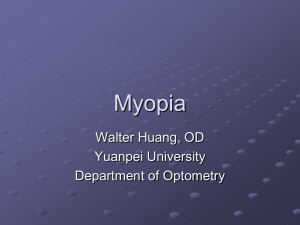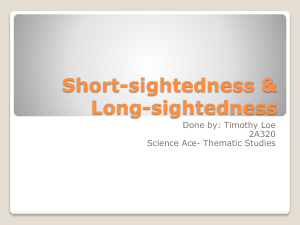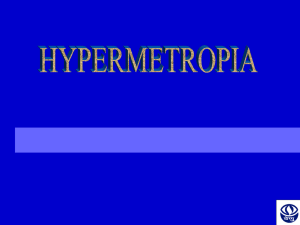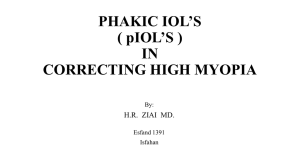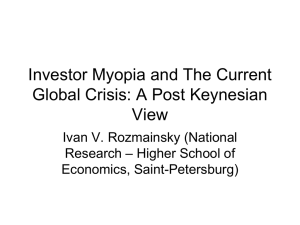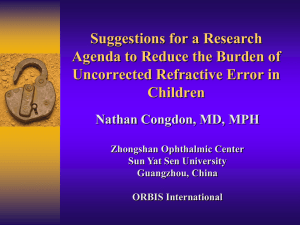Refractive errors
advertisement
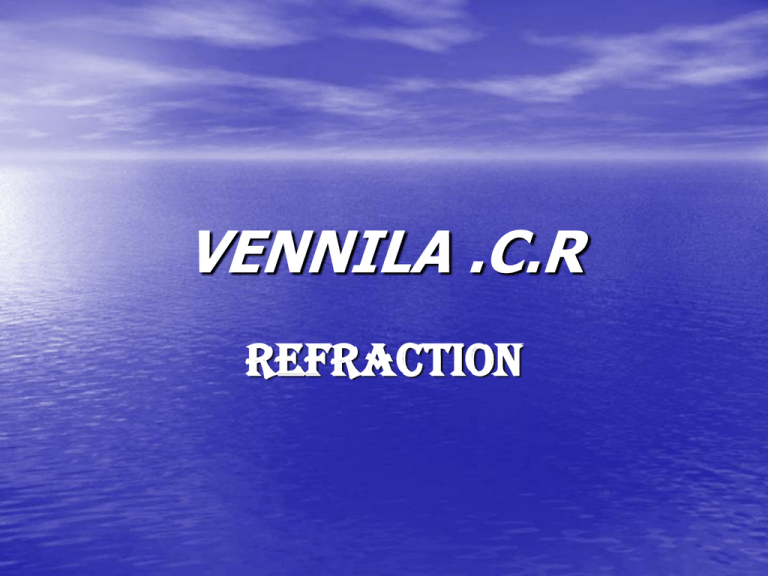
VENNILA .C.R REFRACTION Refractive Errors •Emmetropia •Ametropia Emmetropia • Emmetropia means no Refractive error • It is the ideal condition in which the incident parallel rays come to a perfect focus upon the light sensitive layer of the retina, When accommodation is at rest Ametropia • Ametropia means Refractive error Eye • It is the opposite condition , wherein the parallel rays of light are not focused exactly upon the retina , When the accommodation is at rest Ametropia • Myopia • Hypermetropia • Astigmatism Myopia • Principal focus is formed in front of the retina Causes • Axial Myopia • Curvature Myopia • Index Myopia • Abnormal position of the lens Axial Myopia • Axial myopia results from increase in anteroposterior length of the eye ball. • Normal Axial length- 23mm to 24mm • 1mm increase in AL – 3Ds of Myopia Curvature Myopia • Curvatural myopia occurs due to increased curvature of the cornea and Lens or both. • Anterior surface of the cornea- 7.8mm • Posterior surface of the cornea- 6.5mm • 1mm increases in radius of curvature results in – 6 Ds of Myopia Index myopia • Index myopia results from increase in the refractive index of crystalline lens. Refractive index of normal Lens - 1.42 Abnormal position of the lens • Positional myopia is produced by anterior displacement of crystalline lens in the eye. Accommodative Myopia:. Myopia due to excessive accommodation. Types • Congenital myopia • Simple Myopia (or) Developmental myopia • Pathological Myopia (or) Degenerative myopia • Acquired myopia Congenital myopia • Congenital myopia is present since birth however, it is usually diagnosed by the age of 2 – 3 years. Simple myopia • Simple or developmental myopia is the commonest variety. It is considered as a physiological error not associated with any disease of the eye. • Power limit less than 6D Aetiology • Axial type of simple myopia • Curvatural type of simple myopia Pathological myopia • Myopia associated with degenerative changes in the eye. • Myopia more than 6D to25D or More than 25D Aetiology • Axial growth (i) Heredity (ii) General growth process Acquired myopia Some of the causes of acquired myopia * Index myopia * Curvatural myopia * Positional myopia * Consecutive myopia * Pseudo myopia * Space myopia * Night myopia (or) Twilight myopia * Drug induced myopia Symptoms • Poor vision for distance • Asthenopic symptoms • Exophoria • Muscae volitantes (pathological) • Night blindness (pathological) Signs • Large eye ball • deep Anterior chamber • sluggish Pupil • Large Disc Complications • • • • • • Retinal tear – Vitreous haemorrhage Retinal detachment Degeneration of the vitreous Primary open angle Glaucoma Posterior cortical cataract Posterior staphyloma Treatment • Optical • Spectacle Correction (Concave Lens) Contact lens Surgical PRK Keratomileusis Epikeratophakia Redial Keratotomy Optical Treatment • Concave lens Myopic with Exophoria give full correction. Myopic with Esophoria give under correction. Hypermetropia Principal focus is formed behind the retina Causes • Axial Hypermetropia • Curvature Hypermetropia • Index Hypermetropia • Abnormal position of the lens Axial Hypermetropia • Axial hypermetropia is by far the commonest • In fact, all the new- borns are almost invariably • • hypermetropic (approx,+2.50D) This is due to shortness of the globe, and is physiological. Normal axial length – 23mm to 24mm 1mm decrease in AL – 3Ds of hypermetropia Curvature Hypermetropia • In which the curvature of cornea, Lens or both is flatter than the normal resulting in a decrease in the refractive power of the eye. • Anterior surface of the cornea- 7.8mm • Posterior surface of the cornea- 6.5mm • 1mm increase in radius of curvature results in – 6Ds of hypermetropia Index Hypermetropia • Index hypermetropia occurs due to change in refractive index of the lens in old age. It may also occur in diabetics under treatment. • Refractive index of Normal Lens - 1.42 Classification • Total Hypermetropia may be divided into • (a) Latent Hypermetropia • (b) Manifest Hypermetropia (i) Facultive Hypermetropia (ii)Absolute Hypermetropia Latent Hypermetropia • LH which is corrected physiologically by the tone of ciliary muscle. As a rule latent hypermetropia amounts to only one dioptre. It can be revealed only after atropine cycloplegia. Manifest Hypermetropia MH is made up of two components • Facultative hypermetropia is that part of hypermetropia which can be corrected by the effort of accommodation. • Absolute hypermetropia which can not be overcome by the effort of accommodation. Clinical Types • Simple hypermetropia • Pathological hypermetropia • Functional hypermetropia Simple hypermetropia • It results from normal biological variation in the development of the eye ball. It includes Axial and Curvatural HM. It may be hereditary. Pathological hypermetropia • PH results due to either congenital or acquired conditions of the eye ball which are out side the normal biological variations of the development. The Normal Age Variation • At birth:- 2D to 3 D Commonly Present • At the age of 5 Yrs- 90% of Children’s are Hypermetropic • At Puberty:- Emmetropic Symptoms • Head ache • Blurred vision particular near work • Convergent squint • Early onset of presbyopia • Eye Strain Complications • Eye appears to be small including cornea and anterior chamber becomes shallow • Extreme cases – Microphthalmos • Retinal reflex – Shot silk-Retina Treatment • Optical • Spectacle ( Convex Lens ) Contact lens Hypermetropic with Exophoria give under correction Hypermetropic with Esophoria give full correction Surgical Thermokeratoplasty Astigmatism Astigmatism is that condition of Refraction where the point focus of light cannot be formed upon the Retina Causes • Curvature • • • Ex: Keratoconus, Lenticonus etc.. Centering error Ex: Sub location of the lens Refractive index Ex: Cataract Retinal Oblique placement of macula Types • Regular • Irregular Regular astigmatism • Refractive types • Physiological types Refractive types • Simple astigmatism • Compound astigmatism • Mixed astigmatism Physiological types • With rule astigmatism • Against rule astigmatism • Oblique astigmatism • Bioblique astigmatism Symptoms • Head ache • Blurring of vision • Eye tired • Eye ache • Head Tilt • Half-closure of the lids (High astigmatism) • Blurring & Itching (Low astigmatism) Treatment • Optical Treatment * Cylindrical lens * Under correction * Contact lens (RGP, Toric) • Refractive surgery * Astigmatic Keratotomy * PRK, LASIK Study Reports • Percentage of astigmatism • * 0.25-0.50D * 0.75-1.00D * 1.00-4.00D *>4.00D Percentage of Types * with rule * Against rule * Oblique 50% 25% 24% 1% 38% 30% 32% Duo chrome test To test if the eye has been under corrected or over corrected or is properly corrected Astigmatic Fan To know the axis and power in Astigmatism Jackson cross cylinder To refine the axis and power of cylinder Presbyopia • This is a physiological aging process, In which the near point gradually recedes beyond the normal reading or working distance Causes • Lens matrix is harder and less easily moulded • Lens capsule is less elastic • Progressive increase in size of the lens • Weakening of the ciliary muscle Symptoms • Patient holds the book at arms length • Patient prefers to read in bright light • Eye strain • Head ache • Eyes feels tired and ache Treatment Convex lens Methods of prescription * Occupation * Working distance * Age Surgical * Anterior ciliary sclerotomy * Laser thermal keratoplasty * Small diameter corneal inlays Aphakia • Aphakia means absence of the Crystalline lens from the Eye ball Causes • Congenital • Surgery • Traumatic Optics of Aphakia • Anterior focal distance – 23mm (N-15mm) • Posterior focal distance- 31mm (N-24mm) • The Nodel point of the eye is thus moved forward • Strong converging (convex) lens- +10D Signs • Anterior chamber – Deep • Iris • • • • (i) Iridodonesis (or) Tremulousness (ii) Peripheral button-hole iridectomy mark Pupil - Jet black reflex Absence of the 3rd and 4th Purkinje images Retinoscopy – reveals high hypermetropia and astigmatism Ophthalmoscopy – As in hypermetropic fundus with a small optic disc Disadvantages • Image magnification of about 25-30% • Spherical aberration, Peripheral and Pincushion • Roving ring scotoma (The scotoma extents • • • • from 50°- 65° from central fixation) Jack in the box Restriction of the visual field Coloured vision Inaccurate spectacle correction because of errorneous vertex distance Treatment • Spectacle ( Convex lens ) • Contact lens • Secondary IOL • Epikeratophakia • Keratophakia Aphakic formula P = X / 2 +10.00D P = IOL power X = Refractive power Pseudophakia • Pseudophakia means False lens Image magnification Calculation of IOL power P P A 2.5 L 0.9 K = = = = = = = A-2.5*L -0.9K IOL Power Constant value AC depth Axial length in mm Corneal curvature Corneal diapters Refractive stages of a Pseudophakic eye • Emmetropia • Consecutive myopia • Consecutive hypermetropia Advantages • Image magnification is only 0- 2% • No spherical and prismatic aberrations • Minimum (or) No Anisokonia with rapid return of • • • binocularity Normal Peripheral field of vision and eccentric vision Freedom from handling of the optical devices Cosmetically it is well accepted Disadvantages • Risks and complications may be more • Initially, the cost is more • PCO • CME • IOL related complications Thank “U”
